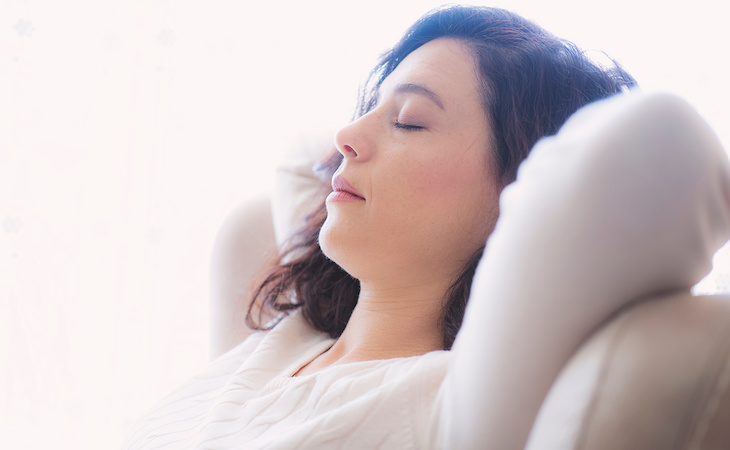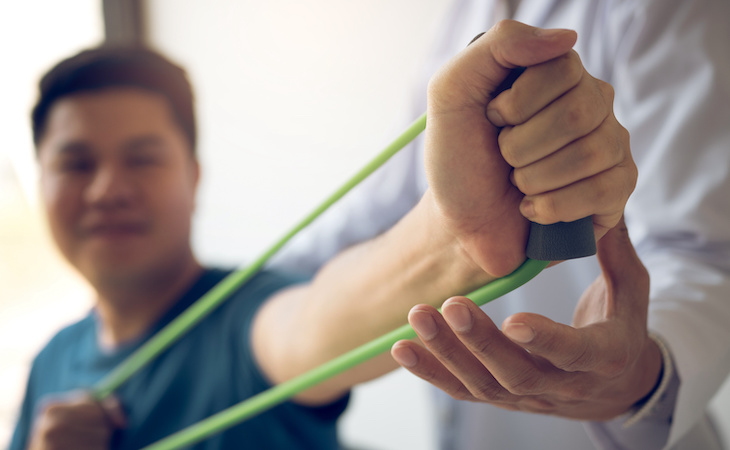Up to 40% of people will experience sciatica in their lifetime, according to Harvard Health. And anyone who has already dealt with this condition knows that pain from sciatica can make it pretty difficult to get a good night’s sleep.
Alex Tauberg, chiropractor and owner of Tauberg Chiropractic & Rehabilitation in Pittsburgh, explains that sciatica is the irritation of the sciatic nerve, “either arising from the sciatic nerve itself or its nerve roots.”
The sciatic nerve is made up of the nerves that leave the lower spine and form one large nerve that runs down the back of each leg all the way into the foot, Tauberg says.
Sometimes, the sciatic nerve can be pinched as a result of compression, inflammation, or injury, which results in the condition known as sciatica. People with sciatica describe the ailment as pain, numbness, or weakness in the lower back and leg.
Having trouble sleeping with sciatica? Here, Tauberg shares his expertise on how to sleep with sciatica and manage the pain.
Causes of sciatica
Sciatica is most commonly caused by nerve root irritation, also known as radiculopathy, says Tauberg. Nerve root irritation can result from a herniated disc or spinal stenosis.
“A herniation occurs when the inner part of the disc protrudes into and possibly past the outer part of the disc,” explains Tauberg. “This can cause the disc to take up space where the nerve exits from the spinal cord. This causes intense inflammation in the area, which can irritate the nerve root, or the protruding part of the disc can directly compress the nerve root.”
Spinal stenosis, on the other hand, “is a narrowing of the pathway through which the spinal cord or nerve roots pass,” says Tauberg. “Spinal stenosis is most often due to degenerative changes in the vertebral bodies. Over time, bony or ligamentous encroachment can occur either in the vertebral canal or in the lateral canals.”
Some people are at higher risk of developing these abnormalities than others. People between the ages of 25 and 55 are at increased risk of disc herniation, says Tauberg. That risk rises even more if you have a job where you repeatedly flex forward at the waist, twist your back, or carry heavy loads. Your risk also goes up if you sit for long periods of time.
People are at a higher risk of developing spinal stenosis, meanwhile, over the age of 50. Other risk factors include spinal injuries, such as from a car accident.
Why sciatica is worse at night
If you noticed that your sciatica feels worse when you get into bed, you’re not alone.
“Sciatica can be worse at night when lying in the horizontal position for an extended period of time,” says Tauberg. Why? Tauberg explains that when you’re lying down, your spinal disc goes through a process called “imbibition.”
“Imbibition is when the spinal disc sucks up surrounding fluid,” he says. “In essence, this is the disc restoring hydration. When this happens, the disc becomes larger or possibly even swollen in nature. When someone has sciatica due to a herniation, this swelling can put more pressure on the nerve roots.”
Can a mattress increase pain?
Tauberg says a mattress that doesn’t properly support your low back could exacerbate sciatica. Here’s what to look for in a mattress if you have sciatica.
The best mattress for sciatica
“When dealing with sciatica, it is advisable to find a mattress that provides good support,” Tauberg says. “A mattress that provides good support for the back allows an individual to move more freely at night. They are able to move into positions with more ease as they don’t have use of their own muscles as much to support the back.”
To ensure your back is being protected in bed, look for a mattress with added lumbar support in the center third. You can find lumbar support in different forms, depending on the type of mattress you choose. Denser foams in the center third of the mattress or an area of reinforced springs are typical methods of lumbar zone enhancement.
Tauberg adds that the best mattress for sciatica is often, but not always, a firm mattress. That’s because a mattress that’s too soft will cause your spine to bow unnaturally, leading to more pain. Some studies show a medium-firm mattress is best for those with sciatica.
Tips for sleeping with sciatica
Beyond your mattress choice, there are a few other things you can do to sleep better with sciatica.
Use pillows strategically
“For people with sciatica who sleep on their backs, I recommend they put a pillow under their knees,” says Tauberg. “In that position, some of the tension is taken off the nerve.”
Switch positions during the night
“While it can be uncomfortable forcing yourself to move into different positions throughout the night, it can be beneficial,” says Tauberg. “Staying in any one position for too long will likely make one feel stiffer when getting up in the morning, which can further aggravate the condition.” (Here’s how to choose the best mattress for osteoporosis.)
Sleep position matters
Speaking of sleep position, you can find an ideal way to sleep with sciatica while resting in your preferred position. Here’s how your sleep position affects sciatica and what you can do to mitigate the pain.
Side
“Sleeping on your side can be beneficial as you are easily able to bend your knees and take pressure off of the sciatic nerve,” says Tauberg.
Back
“This is the position the back is most supported in,” says Tauberg. “The muscles of the back are able to relax significantly in this position.” The downside is that having your legs straight out can put tension on the sciatic nerve. “That’s why a pillow under the knees is recommended,” Tauberg advises.
Stomach
“For some people, stomach sleeping is perfectly fine,” Tauberg says. “And then all of the sudden, it is no longer fine. Stomach sleeping in and of itself isn’t bad, but it can cause pain. When it does, it should be avoided.”
Whether you have sciatica or another condition that affects your back, these back pain-relieving tips can help you sleep better.





